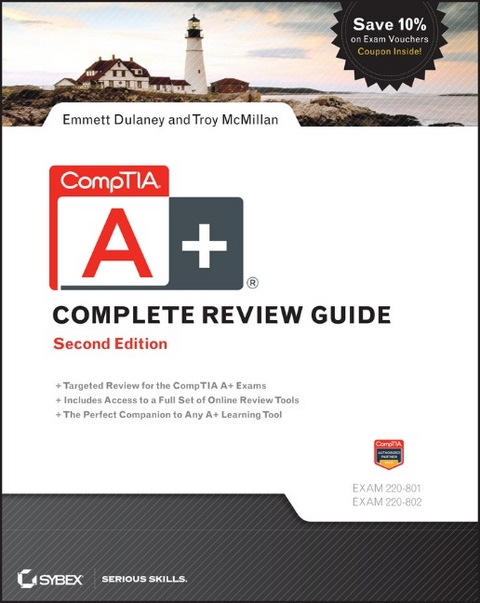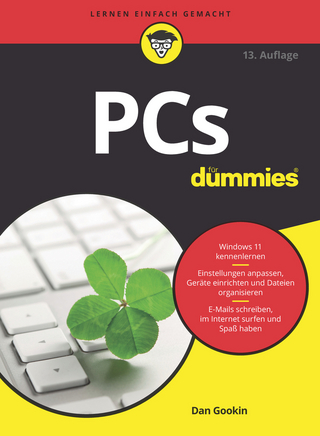
CompTIA A+ Complete Review Guide
John Wiley & Sons Inc (Verlag)
978-1-118-32408-0 (ISBN)
- Titel ist leider vergriffen;
keine Neuauflage - Artikel merken
A concise, focused study aid for the 2012 edition of CompTIA A+ Certification exams More than a million PC technicians hold the CompTIA A+ certification, which is a require certification by some software and hardware vendors. Designed to work with the Sybex family of certification guides for exams 220-801 and 220-802, this Review Guide is organized by objective to provide a quick review and reinforcement of important exam topics. It includes more than 170 review questions, and reader will have access to 4 practice exams, over 100 electronic flashcards, and a searchable Glossary of Key Term.
* Provides effective review and reinforcement to help prepare students for the CompTIA A+ certification exams * A perfect companion to other Sybex CompTIA A+ Study Guides * Covers all exam objectives, including hardware, networking, laptops and printers, operating procedures, operating systems, security, mobile devices, and troubleshooting * Packed with tightly focused review questions, and access to bonus practice exams, electronic flashcards, and a searchable list of key terms to reinforce study * Includes review for both required exams: 220-801 and 220-802 CompTIA A+ Complete Review Guide adds additional support to prepare you to achieve the number one certification for PC technicians.
ABOUT THE AUTHORS Emmett Dulaney, A+, Network+, Security+, MCT, is a respected industry expert. He is currently an assistant professor at Anderson University. He has written several books on Windows, Security, IT project management, and UNIX, including the previous edition of the CompTIA A+ Complete Review Guide and two of Sybex's leading certification titles, CompTIA A+ Complete Study Guide and CompTIA Security+ Study Guide. He is also a well-known certification columnist for CertCities.com. Troy McMillan is a product developer and technical editor for Kaplan IT and holds more than 30 IT certifications, including A+ and Network+. He is also a full-time trainer and the author of Cisco Networking Essentials.
Introduction xxvii Part I CompTIA A+ 220-801 1 Chapter 1 PC Hardware 3 1.1 Configure and apply BIOS settings. 14 Install firmware upgrades flash BIOS 14 BIOS component information 15 BIOS configurations 16 Use built-in diagnostics 19 Monitoring 20 Exam Essentials 22 1.2 Differentiate between motherboard components, their purposes, and properties. 23 Sizes 24 Expansion Slots 25 RAM slots 27 CPU sockets 29 Chipsets 31 Jumpers 32 Power connections and types 33 Fan connections 34 Front Panel connectors 34 Exam Essentials 36 1.3 Compare and contrast RAM types and features. 37 Types 37 RAM compatibility and speed 40 Exam Essentials 41 1.4 Install and configure expansion cards. 41 Sound cards 41 Video cards 42 Network cards 42 Serial and parallel cards 43 USB cards 43 FireWire cards 43 Storage cards 44 Modem cards 44 Wireless/cellular cards 44 TV tuner cards 45 Video capture cards 45 Riser cards 45 Exam Essentials 45 1.5 Install and configure storage devices and use appropriate media. 47 Optical drives 47 Combo drives and burners 48 Connection types 49 Hard drives 54 Solid-state/flash drives 56 RAID types 58 Floppy drive 59 Tape drive 60 Media capacity 60 Exam Essentials 61 1.6 Differentiate among various CPU types and features and select the appropriate cooling method. 62 Socket types 63 Characteristics 63 Cooling 66 Exam Essentials 67 1.7 Compare and contrast various connection interfaces and explain their purpose. 67 Physical connections 67 Speeds, distances, and frequencies of wireless device connections 75 Exam Essentials 76 1.8 Install an appropriate power supply based on a given scenario. 76 Connector types and their voltages 77 Specifications 78 Dual-voltage options 79 Exam Essentials 79 1.9 Evaluate and select appropriate components for a custom configuration, to meet customer specifications or needs. 79 Graphic/CAD/CAM design workstation 80 Audio/Video editing workstation 80 Virtualization workstation 81 Gaming PC 82 Home Theater PC 83 Standard thick client 85 Thin client 85 Home Server PC 86 Exam Essentials 87 1.10 Given a scenario, evaluate types and features of display devices. 87 Types 87 Refresh rates 90 Resolution 90 Native resolution 90 Brightness/lumens 91 Analog vs. digital 91 Privacy/antiglare filters 91 Multiple displays 91 Exam Essentials 92 1.11 Identify connector types and associated cables. 92 Display connector types 92 Display cable types 96 Device connectors and various connector pin-outs 97 Device cable types 102 Exam Essentials 105 1.12 Install and configure various peripheral devices. 105 Input devices 105 Multimedia devices 108 Output devices 109 Exam Essentials 110 Review Questions 111 Chapter 2 Networking 113 2.1 Identify types of network cables and connectors. 117 Fiber 117 Twisted Pair 118 Coaxial 120 Exam Essentials 124 2.2 Categorize characteristics of connectors and cabling. 125 Fiber 125 Twisted Pair 126 Coaxial 128 Exam Essentials 129 2.3 Explain properties and characteristics of TCP/IP. 129 IP Class 130 IPv4 vs. IPv6 131 Public vs. Private vs. APIPA 131 Static vs. dynamic 132 Client-side DNS 132 DHCP 133 Subnet mask 133 Exam Essentials 134 2.4 Explain common TCP and UDP ports, protocols, and their purpose. 135 Ports 135 Protocols 136 TCP vs. UDP 136 Exam Essentials 137 2.5 Compare and contrast wireless network standards and encryption types. 137 Standards 137 Encryption Types 139 Exam Essentials 140 2.6 Install, configure, and deploy a SOHO wireless/wired router using appropriate settings. 140 MAC filtering 140 Channels (1 11) 141 SSID broadcast (on/off) 141 Wireless encryption 141 Firewalls and Port Forwarding/Triggering 141 DHCP (on/off) 142 DMZ 142 NAT 143 WPS 144 Basic QoS 144 Exam Essentials 144 2.7 Compare and contrast Internet connection types and features. 145 Cable 145 DSL 145 Dial-up 146 Fiber 146 Satellite 146 ISDN 147 Cellular (mobile hotspot) 147 Line of sight wireless internet service 147 WiMAX 147 Exam Essentials 147 2.8 Identify various types of networks. 148 LAN 148 WAN 148 PAN 149 MAN 149 Topologies 149 Exam Essentials 150 2.9 Compare and contrast network devices and their functions and features. 151 Hub 151 Switch 151 Router 151 Access point 152 Bridge 152 Modem 152 NAS 152 Firewall 153 VoIP phones 153 Internet appliance 153 Exam Essentials 153 2.10 Given a scenario, use appropriate networking tools. 153 Crimper 154 Multimeter 154 Toner probe 154 Cable tester 154 Loopback plug 155 Punchdown tool 155 Exam Essentials 155 Review Questions 156 Chapter 3 Laptops 157 3.1 Install and configure laptop hardware and components. 159 Expansion options 159 Hardware/device replacement 163 Exam Essentials 168 3.2 Compare and contrast the components within the display of a laptop. 168 Types 168 Wi-Fi antenna connector/placement 169 Inverter and its function 170 Backlight 170 Exam Essentials 170 3.3 Compare and contrast laptop features. 170 Special function keys 171 Docking station vs. port replicator 172 Physical laptop lock and cable lock 173 Exam Essentials 174 Review Questions 175 Chapter 4 Printers 177 4.1 Explain the differences between the various printer types and summarize the associated imaging process. 179 Laser 180 Inkjet 188 Thermal 188 Impact 189 Exam Essentials 190 4.2 Given a scenario, install and configure printers. 191 Use appropriate printer drivers for a given operating system 191 Print Device Sharing 192 Printer sharing 194 Exam Essentials 195 4.3 Given a scenario, perform printer maintenance. 196 Laser 197 Thermal 199 Impact 200 Exam Essentials 200 Review Questions 202 Chapter 5 Operational Procedures 203 5.1 Given a scenario, use appropriate safety procedures. 206 ESD straps 207 ESD mats 208 Self-grounding 208 Equipment grounding 209 Personal safety 209 Compliance with local government regulations 211 Exam Essentials 212 5.2 Explain environmental impacts and the purpose of environmental controls. 212 MSDS documentation for handling and disposal 212 Temperature, humidity level awareness, and proper ventilation 213 Power surges, brownouts, blackouts 214 Protection from airborne particles 216 Dust and debris 216 Handling and Protecting Components 218 Complying with Regulations 218 Exam Essentials 219 5.3 Given a scenario, demonstrate proper communication and professionalism. 219 Use proper language avoid jargon, acronyms, slang when applicable 220 Maintain a positive attitude 220 Listen and do not interrupt the customer 220 Be culturally sensitive 220 Be on time (if late contact the customer) 221 Avoid distractions 221 Dealing with difficult customer or situation 222 Set and meet expectations/timeline and communicate status with the customer 223 Deal appropriately with customers confidential materials 224 Exam Essentials 224 5.4 Explain the fundamentals of dealing with prohibited content/activity. 225 First response 225 Use of documentation/documentation changes 226 Chain of custody 226 Exam Essentials 227 Review Questions 228 Part II CompTIA A+ 220-802 229 Chapter 6 Operating Systems 231 1.1 Compare and contrast the features and requirements of various Microsoft Operating Systems. 240 Windows XP Home, Windows XP Professional, Windows XP Media Center, Windows XP 64-bit Professional 240 Windows Vista Home Basic, Windows Vista Home Premium, Windows Vista Business, Windows Vista Ultimate, Windows Vista Enterprise 241 Windows 7 Starter, Windows 7 Home Premium, Windows 7 Professional, Windows 7 Ultimate, Windows 7 Enterprise 242 Features 244 Upgrade paths differences between in place upgrades, compatibility tools, Windows upgrade OS advisor 249 Exam Essentials 257 1.2 Given a scenario, install and configure the operating system using the most appropriate method. 258 Boot methods 258 Types of installations 259 Partitioning 262 File system types/formatting 263 Load alternate third party drivers when necessary 265 Time/date/region language settings 265 Other Concerns 265 Exam Essentials 265 1.3 Given a scenario, use appropriate command line tools. 266 Networking 266 OS 271 Recovery console 278 Exam Essentials 280 1.4 Given a scenario, use appropriate operating system features and tools. 281 MSCONFIG 284 Task Manager 284 Disk Management 287 Other (User State Migration tool (USMT), File and Settings Transfer Wizard, Windows Easy Transfer) 289 Run line utilities 289 Exam Essentials 291 1.5 Given a scenario, use Control Panel utilities. 291 Common to all Microsoft Operating Systems 291 Unique to Windows XP 295 Unique to Vista 296 Unique to Windows 7 298 Exam Essentials 299 1.6 Setup and configure Windows networking on a client/desktop. 299 HomeGroup, file/print sharing 300 Workgroup vs. domain setup 300 Network shares/mapping drives 300 Establish networking connections 301 Proxy settings 302 Remote desktop 303 Home vs. Work vs. Public network settings 303 Firewall settings 303 Configuring an alternative IP address in Windows 304 Network card properties 304 Exam Essentials 305 1.7 Perform preventive maintenance procedures using appropriate tools. 306 Best practices 306 Tools 309 Exam Essentials 312 1.8 Explain the differences among basic OS security settings. 312 User and groups 312 NTFS vs. Share permissions 314 Shared files and folders 316 System files and folders 319 User authentication 319 Exam Essentials 320 1.9 Explain the basics of client-side virtualization. 320 Purpose of Virtual Machines 320 Resource requirements 321 Emulator requirements 321 Security requirements 321 Network requirements 322 Hypervisor 322 Exam Essentials 322 Review Questions 323 Chapter 7 Security 325 2.1 Apply and use common prevention methods. 328 Physical security 328 Digital security 331 User education 336 Principle of least privilege 336 Exam Essentials 337 2.2 Compare and contrast common security threats. 337 Social engineering 337 Malware 338 Rootkits 338 Phishing 338 Shoulder surfing 339 Spyware 339 Viruses 340 Exam Essentials 346 2.3 Implement security best practices to secure a workstation. 346 Setting strong passwords 347 Requiring passwords 348 Restricting user permissions 348 Changing default usernames 348 Disabling guest account 348 Screensaver required password 348 Disable AutoRun 348 Exam Essentials 349 2.4 Given a scenario, use the appropriate data destruction/disposal method. 349 Low level format vs. standard format 350 Hard drive sanitation and sanitation methods 350 Physical destruction 351 Exam Essentials 352 2.5 Given a scenario, secure a SOHO wireless network. 352 Change default usernames and passwords 353 Changing SSID 353 Setting encryption 354 Disabling SSID broadcast 354 Enable MAC Filtering 354 Antenna and access point placement 354 Radio power levels 355 Assign static IP addresses 355 Exam Essentials 355 2.6 Given a scenario, secure a SOHO wired network. 355 Change default usernames and passwords 356 Assign static IP addresses 356 Disabling ports 356 Physical security 357 Exam Essentials 358 Review Questions 359 Chapter 8 Mobile Devices 361 3.1 Explain the basic features of mobile operating systems. 363 Android vs. iOS 363 Exam Essentials 364 3.2 Establish basic network connectivity and configure email. 365 Wireless/cellular data network (enable/disable) 365 Bluetooth 366 Email configuration 367 Exam Essentials 370 3.3 Compare and contrast methods for securing mobile devices. 370 Passcode locks 370 Remote wipes 371 Locator applications 371 Remote backup applications 371 Failed login attempts restrictions 371 Antivirus 372 Patching/OS updates 372 Exam Essentials 372 3.4 Compare and contrast hardware differences in regards to tablets and laptops. 372 No field serviceable parts 373 Typically not upgradeable 373 Touch interface 373 Solid state drives 374 Exam Essentials 374 3.5 Execute and configure mobile device synchronization. 374 Types of data to synchronize 374 Software requirements to install the application on the PC 375 Connection types to enable synchronization 376 Exam Essentials 376 Review Questions 377 Chapter 9 Troubleshooting 379 4.1 Given a scenario, explain the troubleshooting theory. 387 Identify the problem 387 Establish a theory of probable cause (question the obvious) 388 Test the theory to determine cause 388 Establish a plan of action to resolve the problem and implement the solution 389 Verify full system functionality and if applicable implement preventive measures 389 Document findings, actions and outcomes 389 Exam Essentials 389 4.2 Given a scenario, troubleshoot common problems related to motherboards, RAM, CPU and power with appropriate tools. 390 Common symptoms 390 Tools 396 Exam Essentials 396 4.3 Given a scenario, troubleshoot hard drives and RAID arrays with appropriate tools. 397 Common symptoms 397 Tools 400 Exam Essentials 402 4.4 Given a scenario, troubleshoot common video and display issues. 402 Common symptoms 403 Exam Essentials 406 4.5 Given a scenario, troubleshoot wired and wireless networks with appropriate tools. 406 Common symptoms 406 Tools 410 Exam Essentials 415 4.6 Given a scenario, troubleshoot operating system problems with appropriate tools. 416 Common symptoms 416 Tools 424 Exam Essentials 429 4.7 Given a scenario, troubleshoot common security issues with appropriate tools and best practices. 429 Common symptoms 430 Tools 433 Best practices for malware removal 435 Exam Essentials 436 4.8 Given a scenario, troubleshoot, and repair common laptop issues while adhering to the appropriate procedures. 437 Common symptoms 437 Disassembling processes for proper re-assembly 440 Exam Essentials 441 4.9 Given a scenario, troubleshoot printers with appropriate tools. 441 Common symptoms 442 Tools 447 Exam Essentials 448 Review Questions 449 Appendix A Answers to Review Questions 451 Chapter 1: PC Hardware 452 Chapter 2: Networking 452 Chapter 3: Laptops 453 Chapter 4: Printers 453 Chapter 5: Operational Procedures 454 Chapter 6: Operating Systems 454 Chapter 7: Security 455 Chapter 8: Mobile Devices 456 Chapter 9: Troubleshooting 456 Appendix B About the Additional Study Tools 457 Additional Study Tools 458 Sybex Test Engine 458 Electronic Flashcards 458 PDF of Glossary of Terms 458 Adobe Reader 458 System Requirements 459 Using the Study Tools 459 Troubleshooting 459 Customer Care 460 Index 461
| Zusatzinfo | Illustrations |
|---|---|
| Verlagsort | New York |
| Sprache | englisch |
| Maße | 187 x 234 mm |
| Gewicht | 838 g |
| Themenwelt | Informatik ► Weitere Themen ► Hardware |
| Informatik ► Weitere Themen ► Zertifizierung | |
| ISBN-10 | 1-118-32408-0 / 1118324080 |
| ISBN-13 | 978-1-118-32408-0 / 9781118324080 |
| Zustand | Neuware |
| Haben Sie eine Frage zum Produkt? |
aus dem Bereich


